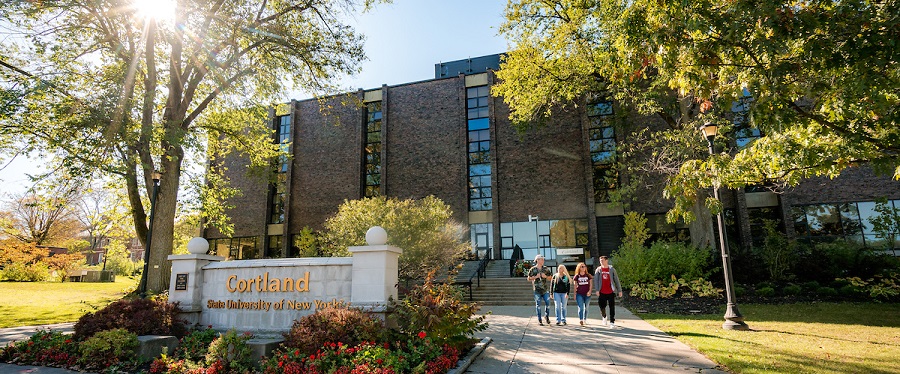
View in printable format (PDF)
As our knowledge and understanding of the novel coronavirus and COVID-19 continues to evolve and federal, state and/or local guidance changes, our policies and plans will be updated.
September 21, 2020
Guiding principles
SUNY Cortland’s policies and protocols for responding to the COVID-19 pandemic are rooted in safety for our faculty, staff and students; safety for the community in which we reside; and safety for our health care providers who are working on the front lines. For this plan to be effective and keep our community safe, it is critical that everyone fully complies with the policies, protocols and guidelines outlined in this webpage.
Cortland’s plans have been created in consultation with the Cortland County Health Department, as well as our local hospital systems. The plans are consistent with guidance from SUNY System Administration, New York State Department of Health and the Governor’s New York Forward Phased Reopening Plan. We will continue to follow recommendations from the federal government and the Centers for Disease Control and Prevention (CDC).
SUNY Cortland would like to recognize and acknowledge those employees who have done essential on-campus work throughout the New York on PAUSE order, including the employees of our affiliated organizations including Cortland Auxiliary, the Child Care Center, the Alumni Association, Cortland College Foundation and the Research Foundation of SUNY. The university would also like to recognize the hard work of all of our employees who have acted quickly and effectively in providing online education to our students throughout this crisis. We thank everyone for their dedication to our campus and the SUNY Cortland community.
Return to the workplace
Process for employees returning to campus
SUNY Cortland’s reopening plan was submitted to SUNY System administration on June 23, 2020, and we are pleased to announce that the plan was approved on June 30, 2020. It has been determined that the university’s plan for reopening meets the minimum standards of the New York State Department of Health’s “Reopening New York Higher Education Guidelines” issued June 20, 2020.
Consistent with the plan, the university is planning to invite employees to return to campus over time in a coordinated process to ensure appropriate physical distancing and maintain appropriate levels of population density within all spaces on campus. Our essential employees returned at 100% June 29 and we are looking to invite our non-essential employees back in phases commencing Aug. 3.
Area vice presidents or department heads/chairs will communicate and coordinate with their employees regarding when and how they will return to on-campus work. Employees should not come to work on campus until they have been scheduled or directed to do so.
As the Governor’s Office of Employee Relations (GOER) has extended the Pilot Telecommuting Program until Oct. 2, 2020, and as part of our phased return for non-essential employees, those who can continue to effectively work remotely will have the opportunity to do so in coordination with their department/office head/chair until restrictions on population density are eased and/or the Pilot Telecommuting Program is discontinued.
The university will start the phased return planning in mid-July and as unit head/chairs work through this process with their non-essential employees, various considerations should be used in scheduling this phased return. These considerations should include, but are not limited to:
- An employee’s desire to return to the workplace as opposed to working remotely
- Child/elder care needs
- Health concerns
- An employee’s need to serve our returning students
- Need to access on-site resources
- Whether the employee’s on-site work location allows for appropriate physical distancing.
Employees may be asked to report to work on campus only on specific days and/or at specific times to reduce population density within workspaces to reduce the possibility of virus spread. Upon completion of the planning process, each department/office will develop a phased staffing plan for approval to their respective vice president. It is preferred that these staffing plans for non-essential employees include employees that will continue to telecommute, and in this case, formal applications for telecommuting will not be needed. Individual telecommuting work plans may need to be updated.
If during the return to work planning process, a non-essential employee’s desire to continue to work remotely is not fully met, that employee may complete an application for telecommuting for further review and consideration.
As on-campus staffing expands, the university will closely monitor and reassess our policies and procedures to mitigate any potential spread of the virus. Daily self-screenings and testing when appropriate will be a critical part of assessing the impact of increased staffing. If localized outbreaks emerge, tighter restrictions and reduced staffing may need to be implemented again.
Levels of on-campus staffing, services permitted on campus and government guidance may change. This webpage will be regularly updated to reflect any such changes.
Telecommuting options
Non-essential employees may continue to take advantage of the telecommuting policy to accommodate any needs that would prevent or interfere with their regular attendance in the workplace. It is preferred that the use of the telecommuting program as a means to accommodate personal needs be considered and incorporated in the departmental staffing plan. If a mutually beneficial arrangement cannot be reached as part of the staffing plan, an individual application can be submitted.
K-12 education and child care needs vary from district to district. The university will work to try to accommodate these needs to the best of our ability as the university balances operational need.
Employees who are considered non-essential and can complete their obligations remotely may request to participate in telecommuting if it has not been written into the department return-to-work staffing plan. During the term of the Statewide Telecommuting Pilot Program, such requests should be granted to the greatest extent possible. An interested non-essential employee may submit a Telecommuting Application to their office/department head/chair. The office/department head/chair will review the employee Telecommuting Application to make an initial determination whether an employee meets the criteria within 48 hours. The application will then be sent to the Human Resources Office for final approval which will be provided within 48 hours of receipt.
All responses will be in writing. Once a Telecommuting Application has been approved, participation and start dates may be subject to equipment availability. Telecommuting is not an employee entitlement and is not operationally feasible for all job functions. Management determinations as to which job functions are eligible for telecommuting are final and cannot be appealed. Full discretion to either approve or disapprove an application for telecommuting rests solely with management, but applications should be widely granted so long as they are consistent with operating need. An individual’s participation in the Pilot Program can be suspended or canceled at management’s sole discretion with 48 hours’ advance written notice to the employee.
Requesting reasonable accommodations
As we welcome students back to our community, our goal will be to provide as many opportunities for in-person experiences and interactions as possible, and accordingly, some positions may be deemed essential and expected to be on campus to deliver essential services. We understand that some employees may have limitations due to exposure to COVID-19 and therefore may need to request a reasonable accommodation to avoid harm to their health. We have identified two categories of employees who may request a temporary accommodation to fulfill all their fall 2020 essential obligations:
- Employees who are in a high-risk group for contracting COVID-19 due to age (65 or over) or because they have serious underlying medical conditions. (Detail on these risk factors can be accessed on the CDC website.)
- Employees who are living with and/or caring for a family member who is a member of a high-risk group as defined above.
Essential employees, or non-essential employees who do not wish to apply through the telecommuting process due to confidentiality concerns, who wish to request consideration for a temporary reasonable accommodation should complete a confidential Reasonable Accommodation Request Form consistent with the university’s ADA policy. Please include as many specifics as you can in the request. Please submit requests to [email protected].
Requests for reasonable accommodation can be made at any time. Please direct any questions or concerns about this process to Jennifer Eckert-Dennison, human resources associate and designee for reasonable accommodation, or to Gary Evans, associate vice president for human resources.
Requirements for returning and symptom monitoring
New York state has placed two requirements on all employees (faculty and staff) as a condition for returning to the workplace. Essential employees who have continued to work throughout our pause are also required to complete these NYS mandated items.
A “Back to Work” channel in the Faculty/Staff tab of myRedDragon is available to host these requirements and supporting documentation for utilizing them.
These requirements are*:
- A one-time viewing of a 12-minute New York State COVID- 19 Response: Return to Work Training This video should be viewed prior to returning to the campus as part of your normal remote workday, or for those who have continued to report through this pause, within three workdays of being informed of this requirement. Those who may not have the technological capability in their remote location should watch the video their first day back in the office.
- A daily self-screening health and symptom questionnaire. This shall be completed each day an employee enters their campus workspace. Additional detail on this questionnaire is below.
*If an alternate delivery method of these requirements is needed, please email [email protected].
The daily self-screening questionnaire should be completed prior to arriving to campus, but no later than an employee’s first few minutes in their specific work location. It will accessible as either a smartphone app or through a link in the “Back to Work” channel of myRedDragon.
The questionnaire will authenticate via the employee’s NetID and will pose five related questions:
Are you experiencing any of the following today:
- Temperature 100 degrees Fahrenheit or greater?
- Any known close contact with a person confirmed or suspected to have COVID-19 in the past 14 days?
- Currently experiencing any of the following symptoms? Cough, shortness of breath, troubled breathing, fever, chills, sore throat, new loss of taste, new loss of smell, congestion or runny nose, nausea or vomiting, or diarrhea?
- Tested positive for COVID-19 through a diagnostic test in the past 14 days?
- Traveled to any other state subject to the incoming travel restrictions in the past 14 days?
If an employee responds “yes” to any of the above questions, an email will be sent to Human Resources; the employee will receive an automated response message directing that the employee should not report to work, should inform their supervisor, and should contact their primary health care provider or one of the local COVID-19 hotlines (see below). Employees with any questions may also call Human Resources at 607-753-2302.
If the employee’s response to all questions is “no,” they may report to work on campus. The information will be sent to a confidential database maintained by Campus Records. Each day, at various times throughout the day (10 a.m., 2 p.m., 6 p.m. and midnight), supervisors will receive an email list identifying by name the employees working under their supervision who have completed the self-screening questionnaire since the last notice.
If an employee is present in the workplace and has not completed their screen, it will be the supervisor’s responsibility to provide a gentle reminder to complete the screening immediately, and in certain circumstances, after consultation with Human Resources, the employee may be directed to go home.
Sample screenshot of questions from iPhone application:
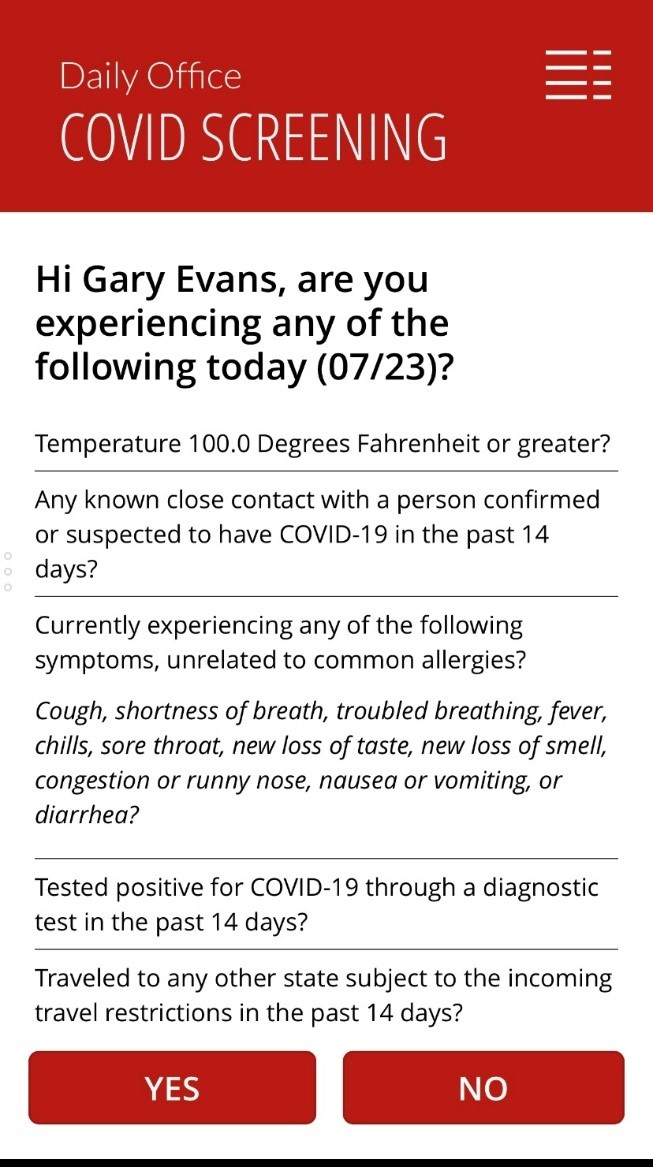
Employees may not report to work on campus if they are feeling ill. The most commonly reported symptoms of COVID-19 include the following:
- Cough
- Shortness of breath or difficulty breathing
- Fever
- Chills
- Repeated shaking with or without chills
- New runny nose or sinus congestion
- Muscle pain
- Persistent headache
- Sore throat
- Unexpected severe fatigue
- New gastrointestinal symptoms
- New loss of taste or smell
Because many of these symptoms may occur briefly or as a result of common allergies, or other conditions, employees should self-monitor for any unusual occurrences. Upon the onset of any of these symptoms, employees should call their primary health care provider or one of the following COVID-19 hotlines and follow the advice or instructions:
- Cortland County COVID-19 Hotline: 607-756-3415
- Guthrie Cortland Medical Center COVID-19 Screening and Testing: 607-299-7676
134 Homer Ave., Cortland, NY 13045
Testing 9 a.m. to 3 p.m. Monday through Friday and 8 to 11 a.m. Saturdays - Cortland County Health Department: 607-753-5036
Employees should follow the instructions of their primary health care provider and/or the Cortland County Health Department if instructed to self-quarantine or self-isolate as a result of COVID-19 symptoms, a positive COVID-19 test, or contact with someone who has COVID-19 symptoms or a positive COVID-19 test. Contact tracing protocols and communication will be coordinated by the Cortland County Health Department. Employees should also notify their SUNY Cortland supervisor and the Human Resources Office ([email protected] or 607-753-2302).
Specifically:
- The university will work closely with the state and local health departments to ensure appropriate contact tracing, communication, isolation and/or quarantine protocols are administered.
- If an employee has COVID-19 symptoms and either tests positive for COVID-19 or did not receive a test, the individual may only return to work after completing at least 14 days of self-quarantine and after symptoms have subsided. In these situations, the employee should speak to Human Resources for appropriate advice related to leave option, accruals, return-to-work requirements, etc.
- If an employee does not have COVID-19 symptoms but tests positive for COVID-19, the individual may only return to work after completing at least 14 days of self-quarantine.
- During the period of quarantine and while the employee is asymptomatic and/or able to work, remote work opportunities will be explored as an option prior to the required charge of accruals.
- If an employee has had close contact with a person with COVID-19 and is experiencing potential symptoms of COVID-19 — even if symptoms are deemed not related to COVID-19 — the employee must still complete a 14-day quarantine after the contact.
- If an employee has had close contact with a person with COVID-19, even if the employee is not experiencing COVID-19 symptoms, the individual must complete a 14-day self-quarantine.
According to the CDC, individuals with certain conditions may have a higher risk for COVID-19 infection. Those conditions may include:
- Older adults (aged 65 years and older)
- Undiagnosed or untreated HIV
- Asthma (moderate to severe)
- Chronic lung disease
- Diabetes
- Serious heart conditions
- Chronic kidney disease being treated with dialysis
- Severe obesity
- Being immunocompromised (e.g., someone currently taking prednisone or being treated for cancer)
Essential employees who have been instructed to return to campus and have concerns about doing so due to a high-risk condition identified by the CDC, which include being an older adult, pregnant, and/or residing with or caring for a person with a high-risk condition, may wish to seek a reasonable accommodation under the Americans with Disabilities Act (ADA). A full list of high-risk factors identified by the CDC can be accessed on the CDC's website.
Information resources
The university will not be able to provide a laptop or other similar device to all telecommuters. The use of an employee’s personal computer may be dependent on the use of Virtual Desktop Infrastructure (VDI) or Virtual Private Network (VPN) or Access to Email, OneDrive and/or SharePoint via Outlook Web Access, all of which may require authentication and security thresholds. Management will determine which connection mechanism is appropriate based on operational need.
Generally, the telecommuter must have an internet connection with bandwidth and a computer that is appropriate for conducting official business without disruption. The telecommuter is responsible to secure and pay for an internet connection. The agency will not reimburse internet costs. In limited instances, telecommuting assignments that do not require an internet connection may be available. Where such assignments meet operating needs, they can be made/approved.
The telecommuter is responsible for having a phone for all work-related calls and the university will not reimburse phone or data costs. Any employees who are using campus-owned technology at their remote worksite must return all such technology to the university workspace upon returning to the workplace or upon the expiration of the telecommuting pilot program.
Information Resources (IR) will do their best to support any technical needs the employee may have. For those employees working remotely, they will provide this assistance to the extent possible. For those working on campus, if a visit to an employee’s office becomes necessary, the employee should make every effort to not be present when tech staff is present. If IR support staff determines that the user needs to be present, the user will need to practice physical distancing or wait outside the office space.
Health and safety guidance — personal safety practices
Physical distancing
Maintaining physical distance is one of the best tools both to avoid being exposed to COVID-19 and to slow its spread. Since people can spread the virus before they know they are sick, it is important to stay away from others, even if you or they have no noticeable symptoms. Physical distancing is important to help prevent people from getting sick. Employees working on campus must follow these physical distancing practices:
- Stay at least six (6) feet from other people at all times unless safety of the core activity requires shorter distance, such as personal care of an injured or sick individual, lifting or moving that requires multiple persons, etc. Two arms’ lengths is a good rule of thumb to approximate this distance.
- Avoid gathering in groups.
- Avoid more than one person in a confined space such as elevators or vehicles.
- Avoid mass gatherings.
- Limit in-person gatherings/meetings as much as possible. Utilize Webex or other virtual meeting options whenever possible. If in-person meetings are held, attendees shall be spaced out appropriately and wear their face coverings for the duration of the meeting.
Follow directional signage for the flow of traffic to reduce frequency of close passing.
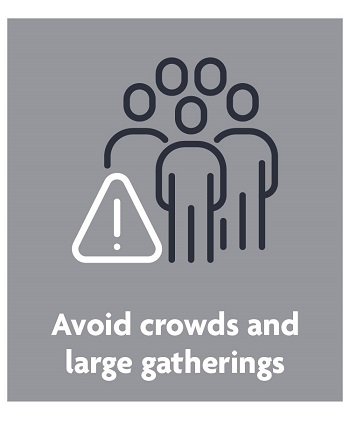
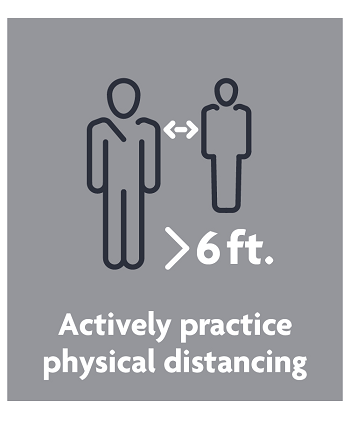
Cloth face coverings
In response to the COVID-19 pandemic, SUNY Cortland has adopted a Face Covering and Mask Requirements Policy. This policy highlights the protections that are required and implemented to ensure the health and safety of our campus community including students, faculty, staff, visitors and contractors.
All members of the campus community are required to wear face coverings when in direct contact with students, faculty, staff, visitors and contractors, except where doing so would inhibit or otherwise impair that individual’s health. Direct contact is when a person leaves their work station and walks about the office space, enters a hallway, transverses a building, or goes outside and has the potential come within six feet of another person.
A face covering is a fabric mask that covers the nose and mouth. It can be secured to the head with ties, straps, ear loops or simply wrapped around the lower face. It can be made of a variety of fabrics, such as cotton, silk or linen. A cloth face covering may be factory-made, sewn by hand or can be improvised from household items such as scarves, T-shirts, sweatshirts or towels. Face coverings should NOT have ventilation ports.
The university will provide three (3) cloth face coverings for all employees. It is the responsibility of employees to maintain their face coverings and have them available each day. Replacements will be available for emergencies or to replace worn or damaged cloth face coverings; however, employees should not expect an endless supply of cloth face coverings to be provided. To ensure their safety, employees should wear cloth face coverings for one (1) day at a time, and then properly launder them before repeat use. Employees may also provide their own, which will help reduce the need for the university to purchase additional face coverings. Disposable masks will also be available to employees by SUNY Cortland, if requested, on a case-by-case basis. Departments/offices have placed orders for supplies to be on hand and additional supplies can be ordered through Central Stores. Disposable masks may only be worn for one (1) day and then must be discarded.
Outdoors
All employees, students and visitors are required to have a cloth face covering readily available on their person (e.g. around neck) when they venture outdoors on campus, and they must put on their face covering when it is NOT feasible to maintain physical distancing measures (i.e. at least 6 feet of separation between others). If sharing a vehicle (work-issued or personal vehicle) for work-related travel, all persons aboard the vehicle shall wear a face covering.
Indoors
Anyone entering a building must put on a face covering prior to entering the building and to continue to wear the face covering in common areas such as elevators, lobbies, hallways, classrooms, laboratories, restrooms and when traveling around the building and working in shared spaces. Additionally, face coverings are required in common areas of residence halls, dining halls, the Student Life Center, the SUNY Cortland Campus Store and other retail locations and gathering spaces across campus. Face coverings may only be removed when employees are working alone in a cubicle, office or other designated area, following physical distancing guidelines.
Cloth face coverings should:
- Fit snugly but comfortably against the face
- Be secured with ties or ear loops
- Include multiple layers of fabric
- Allow for breathing without restriction
- Be able to be laundered and machine-dried without damage or change to shape.
As defined under the Occupational Safety and Health Administration (OSHA), cloth face coverings are not Personal Protective Equipment (PPE). They are worn by a person to prevent community spread from an asymptomatic person. PPE, on the other hand, is equipment worn by people to protect themselves from present or potential hazards and include surgical masks, respirators such as N95s, safety glasses, lab coats, etc.
Employees who are unable to wear a face covering due to a medical condition or other protected reason may submit a request for reasonable accommodation under the ADA.
See details regarding cloth face covering use and care below.
| Required for campus community use in non-healthcare settings (office spaces, general work settings, shops, community areas) where 6 feet of physical distancing cannot be consistently maintained. Must be replaced daily. Not required for working alone in office. Required for ingress/egress. | ||
| Type |
Cloth face covering |
Disposable mask |
|---|---|---|
| Example |  |
 |
| Description | Homemade or commercially manufactured face coverings that are washable and help contain wearer’s respiratory emissions | Commercially manufactured masks that help contain wearer’s respiratory emissions |
| These masks are reserved for healthcare workers and other approved personnel with task-specific hazards determined by SUNY Cortland’s Environmental Health and Safety Office. Required for campus community use in non-healthcare settings (office spaces, general work settings, shops, community areas) where 6 feet of physical distancing cannot be consistently maintained. Must be replaced daily. Not required for working alone in office. Required for ingress/egress. | ||
| Type |
Medical-grade surgical mask |
N95 respirator |
|---|---|---|
| Example | 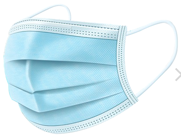 |
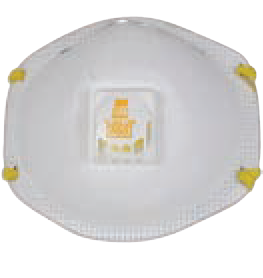 |
| Description | FDA-approved masks to protect the wearer from large droplets and splashes; helps contain wearer’s respiratory emissions | Provides effective respiratory protection from airborne particles and aerosols; helps contain wearer’s respiratory emissions |
Cloth face coverings assist people who may have the virus without being aware of it from spreading the disease. Wearing of cloth face coverings also aids in slowing the spread of the virus. The Centers for Disease Control and Prevention (CDC) advises the use of simple cloth face coverings to prevent transmitting diseases to others. Furthermore, it is important to observe the following guidance:
- Wear a cloth face covering in public settings where other social distancing measures are difficult to maintain. This action will help slow the spread of the virus.
- If you are using a disposable face mask, it is important to understand that they are intended to be worn for a limited period of time. Disposable masks should be replaced after one (1) day of continuous use or if it becomes damaged or soiled.
- It is critical to emphasize the need to maintain 6-feet social distancing even while wearing a cloth face covering to further slow the spread of the virus.
- Individuals may wear their own store-bought or homemade cloth face covering or a scarf or bandana if they so choose. Instructions on making a cloth covering can be found at Centers for Disease Control and Prevention.
- Cloth face coverings are preferred over disposable masks since they can be easily washed and reused. This will also cut down on the demand for a critical resource that is used by healthcare workers and first responders.
- Use reusable face coverings and masks until they become damaged, soiled or wet. A damaged covering should be disposed of.
- Keep a backup covering or mask available.
- Do not use a mask with a vent as it releases unfiltered air to the environment.
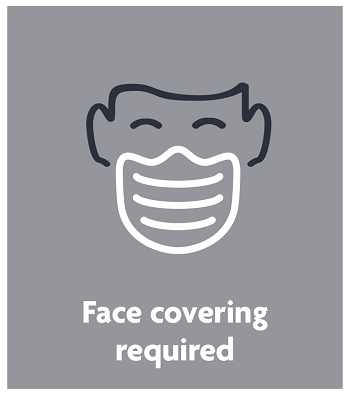
How to wear a cloth face covering
- Wash your hands with soap and water for at least 20 seconds.
- If the cloth face covering has ear loops, put one loop around each ear.
- If the cloth face covering has ties, pick up the cloth face covering by the ties and tie the upper ties behind your head with a bow.
- If the cloth face covering has a lower tie, then once the cloth face covering is fitted to the bridge of your nose, tie the lower ties behind your head with a bow.
- Make sure the cloth face covering is completely secure. Make sure it covers your nose and mouth so that the bottom edge is under your chin.
- Wash your hands with soap and water for at least 20 seconds.
How to remove the cloth face covering
- Wash your hands before removing the cloth face covering.
- Do not touch the inside of the cloth face covering (the part over nose and mouth). It may be contaminated from your breathing, coughing or sneezing.
- Untie or remove the ear loops and remove the cloth face covering by the straps.
Wash after use in the washing machine with hot water and completely dry on medium or high heat in the dryer.
Employees not wearing face coverings
An employee (Employee A) may experience a situation where another employee (Employee B) is not following our face covering requirements. Employee B may be trying to enter a workspace, office, elevator, conference room, etc. or otherwise interacting with Employee A closer than physical distancing requirements. Employee A has the right to request Employee B to don their mask or to refuse service to Employee B and ask them to leave the area. If Employee B refuses to don their mask, or repeatedly fails to follow protocol, please report Employee B to their supervisor and/or to Human Resources. It is anticipated that no employee or student will be provided an accommodation eliminating the need to wear any face covering or mask while in the workplace and interacting with others.
Specific procedures are being identified for similar situations involving students and will be disseminated by the Student Conduct Office.
Face shields
A face shield is predominately used for eye protection and is defined as a protector intended to shield the wearer’s face, or portions thereof, from certain hazards, as indicated by the face shield’s markings and shall not be considered a routine alternative to a cloth face covering. However, it has been determined by the Cortland County Health Department that a face shield may be appropriate in certain circumstances related to COVID-19.
For employees who are unable to wear a cloth face covering due to health reasons, a face shield may be an appropriate reasonable accommodation; please contact Jennifer Eckert-Dennison, human resources associate and designee for reasonable accommodations, at [email protected] or 607-753-2302. She will work with the employee to evaluate the specific circumstances, work context and alternatives.
It will be acceptable to wear a face shield within a standard classroom setting, where physical distancing is greater than 6 feet. This allows an instructor to present material and allow students to read lips and see the instructor’s face. However, once the classroom lecture is over, the instructor shall immediately put on a cloth face covering or mask to directly interact with students or to leave the classroom.
Face shields in any other circumstance shall be worn with a face covering, such as a medical mask or a cloth face covering. Face shields without a face covering are not acceptable for usage in laboratories, studios, offices, hallways or any other situation where the instructor or occupant frequently is within six feet of students, faculty, staff, visitors and contractors.
Face shields shall be sanitized immediately after use. The face shield shall be cleaned with a suitable sanitizer by spraying the entire face shield, wiping with a paper towel and allowing the sanitizer to air dry. Store the face shield in a location where it will not be scratched or damaged. Ensure that the band that holds the face shield to the head is not damaged or worn prior to wearing.
Handwashing
Employees should wash their hands often with soap and water for at least 20 seconds, especially after being in a public place, or after blowing their nose, coughing, sneezing or touching their face. If soap and water are not readily available, use a hand sanitizer provided by the campus or one that contains at least 60% alcohol, covering all surfaces of the hands and rubbing them together until they feel dry. Employees should avoid touching their face whenever possible, and if they do, should wash their hands afterward.
Note on use of disposable gloves: According to the CDC, gloves are not necessary for general use and do not replace good hand hygiene. Washing hands often is considered the best practice for common everyday tasks.
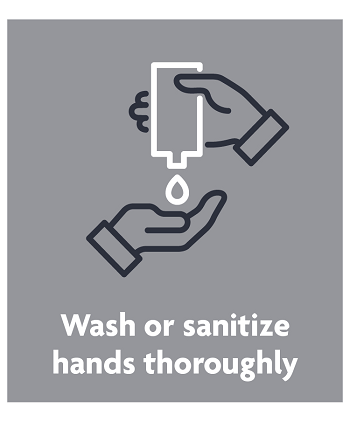
Disinfection of workspaces and commonly used surfaces
While Custodial Services will continue to clean and disinfect frequently touched surfaces (e.g. door handles, sink handles, water bottle refill stations, grab bars, hand railings, bathroom stalls and dining hall tables) based on CDC guidelines, all employees should take an active role in helping keep their workplaces clean and sanitized. Employees should wipe down commonly used surfaces. Before starting work and before leaving any room in which an employee has been working, they should wipe down all work areas with EPA-registered disinfectant provided by the university. This includes any shared-space location or equipment (e.g. copiers, printers, computers, A/V and other electrical equipment, coffee makers, desks, tables, etc.). Departments/offices have placed orders to have a supply of these items on hand. Additional items can be ordered from Central Stores.
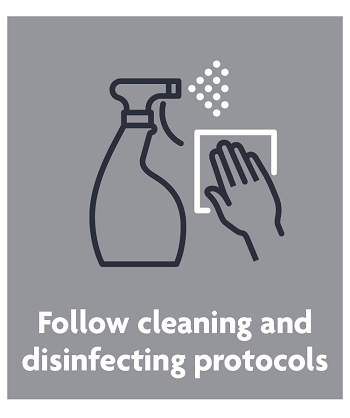
Coughing/sneezing hygiene
When sneezing or coughing, employees should cover their mouths and noses with a tissue or use the insides of their elbows. Used tissues should be thrown in the trash immediately, and the employees should wash their hands. If soap and water are not readily available, hand sanitizer that contains at least 60% alcohol is an acceptable substitute.
Mental and emotional well-being
During the COVID-19 public health emergency, individuals can take the following steps to manage stress and anxiety levels:
- Manage information flow by choosing reliable sources and establish boundaries on checking for updates.
- If you have children, help your school-aged children and adolescents set boundaries on their information flow in the same manner as setting personal boundaries and assure children that it is OK to feel scared or anxious.
- Practice good self-care by exercising, eating healthy foods, practicing mindfulness, sleeping enough at night and going outside when possible.
- Seek peer support to stay connected. Seek those who understand your experiences and can help problem-solve
- Facilitate ways to maintain social connections: personal, family and friends. This might include technological assistance or coordinating times with others to physically check in on vulnerable individuals
The Employee Assistance Program (EAP) is available to offer emotional support and resources during this stressful period. Obtaining EAP services is as easy as making a phone call. Coordinators will connect employees to the services they need, professionally and confidentially. For further information, contact one of the SUNY Cortland EAP coordinators:
- Tina Aversano: 607-753-2446
- Lynda Shute: 607-753-2214
- 24-hour voicemail will accept messages: 607-753-5777
- 24/7 EAP hotline: 1-800-822-0244.
Workplace guidance
Common areas and workspaces
In general, cloth face coverings shall be worn at all times in common areas and while in the presence of others. It is best practice to have a cloth face covering available to don immediately at all times.
Cloth face coverings must be worn in all common areas, including, but not limited to:
- Reception/receiving areas (for those visiting or passing through those areas)
- Hallways
- Break rooms
- Conference/meeting rooms
- Any common areas (kitchens, restrooms, etc.)
Employees whose primary workstation is in a shared workspace or office should wear a cloth face covering when physical distancing cannot be consistently maintained. Even if a specific workstation has a plexiglass barrier installed, the employees shall wear a cloth face covering when interacting with others at their desks.
Cloth face coverings shall be worn when entering and exiting all offices. Any employee visiting or passing through a shared workspace shall wear a cloth face covering.
Cloth face coverings are not required inside singly occupied workspaces, including cubicles that provide appropriate physical distancing.
Employees whose primary workspace is outdoors need not wear a cloth face covering as long as physical distancing can be maintained but should always have one available to don immediately if someone else approaches.
Departments should continuously assess open work environments and meeting rooms and work with Facilities Operations and Services on measures to ensure appropriate physical distancing between employees, other coworkers and students such as:
- Place visual cues such as floor decals, colored tape (specifically provided by Facilities Operations and Services) or signs to indicate to colleagues where they should stand while waiting in line. Masking tape shall never be used on walls or furniture.
- Place one-way directional signage in large open workspaces with multiple through-ways to increase distance between employees moving through the spaces.
- Consider designating specific stairways for up or down traffic if building space allows.
Area vice presidents and office/department heads/chairs will work to ensure that each employee returning to work on campus understands and adheres to the policies and procedures in effect in their specific work environments.
Classroom-based instruction
SUNY Cortland analyzed Computer-Aided Design (CAD) drawings of all our 105 instructional spaces to determine the maximum capacity of each location that would enable occupants to maintain recommended distances. Seats will be placed within a 96-inch diameter circle with 7-10 feet of teaching zones in front of them. Under these parameters, seating capacity of all rooms will be significantly reduced, with the vast majority of spaces only able to accommodate between 20% and 50% of the normal number of seats. We also identified an additional 12 to 15 spaces that could be converted for classroom use under physical distancing conditions. We therefore expect to utilize approximately 120 classrooms for the fall semester. All instructional spaces that are too small to accommodate academic activities while maintaining physical distance protocols will be closed.
Using restrooms
Use of restrooms with multiple stalls should be limited based on room size to ensure at least six (6) feet of distance between individuals. Employees should wash their hands with soap for at least 20 seconds after using restroom facilities to reduce the potential transmission of the virus.
Using elevators
Please limit the use of elevators to no more than two (2) people at a time. Employees are encouraged to use the stairs whenever possible. Cloth face coverings must be worn while using the elevator, and care should be taken to avoid touching the elevator buttons with exposed hand/fingers, if possible. (Using one’s elbow is a good alternative to using one’s fingers.) Employees should wash their hands or use hand sanitizer with at least 60% alcohol upon departing the elevator. Buildings with multiple elevators may have specific elevators designated as up or down only. Please follow any postings.
Meetings
Convening in groups increases the risk of viral transmission. Whenever feasible, meetings should be held in whole or part using the extensive range of collaboration technology available (e.g. Microsoft Teams, Webex, Blackboard, telephone, etc.).
In-person meetings are limited to the restrictions of local, state and federal orders and should not exceed 50% of a room’s capacity, assuming individuals can still maintain six (6) feet of separation for physical distancing requirements. Departments and offices should remove or rearrange chairs and tables or add visual cue marks in meeting rooms to support physical distancing between attendees. Department/office personnel should take the lead on physical spacing/visual cues in assigned meeting rooms; this will best support custodial staff prioritizing cleaning and sanitation. Cloth face coverings shall be worn by everyone participating in an in-person meeting.
Employees are encouraged whenever possible to communicate with colleagues and supervisors as needed by Microsoft Teams, email, instant message, telephone or other available technology rather than face-to-face.
Meals
Before and after eating, employees should wash their hands thoroughly to reduce the potential transmission of the virus.
If dining on campus, employees should wear a cloth face covering until they are ready to eat and then replace it immediately afterward. Eating establishments must meet requirements to allow at least six (6) feet of distance between each customer, including lines and seating arrangements. Employees are encouraged to take food back to their office area or eat outside (weather permitting), while continuing to maintain appropriate physical distancing.
If eating with others present, individuals should maintain six (6) feet of distance between each other and should not sit facing one another.
After eating or preparing food in common areas, wipe all surfaces, including table, refrigerator handle, coffee machine, etc. using cleaner/wipes provided in these spaces.
Public transportation
Employees who take public transportation should wear a cloth face covering before entering the bus and avoid touching surfaces with their hands. Upon disembarking, employees should wash their hands or use hand sanitizer with at least 60% alcohol as soon as possible and before removing their cloth face coverings.
Control of entry/exit
Control of entry/exit
As the university starts to reopen, building access points may be limited, both in terms of access point usability and the hours of unlocked access. A SUNY Cortland ID card or key will be required for entry as appropriate. During the time of limited building access, employees should be cognizant of letting non-employees into buildings. A non-employee and non-student visitor policy will be implemented. Cloth face coverings should be worn while entering and exiting SUNY Cortland facilities.
Departments, offices and building coordinators should identify usable building access points and coordinate employee arrival and departure times to reduce congestion during typical “rush hours” of the business day. Department heads should schedule employee arrivals and departures in increments to reduce personal interactions at building access points, hallways, stairs/elevators, etc.
Once employees have been instructed to return to work on campus, they should report to work or depart work through the designated building access and at the designated time to limit the number of people entering and exiting buildings at any one time.
If an individual is not a current employee or current student of the university, they will be considered a visitor/guest. Visitors at this time shall be limited and subject to the SUNY Cortland Visitor Policy and Procedures which minimally require a record of their presence, cloth face coverings, physical distancing and health screenings.
Other resources
Restart information
- Fall 2020 Campus Guide
- SUNY Cortland's Restart Plan (PDF)
- NY Forward
- Cleaning Supplies and Disposable Mask Order Form
Accommodation and leaves information
- ADA: SUNY Cortland Disability and Workplace Reasonable Accommodation
- ADA Reasonable Accommodation Request Form
- Telecommuting Pilot Program
- Telecommuting Application Form
- Expanded Sick Leave and FMLA Coverage
Exposure and return-to-work information
- Incoming Travel Advisory and Quarantine FAQs
- Employee Exposure and Testing Protocols
- Essential Employee Return to Work Protocols
- Face Covering Requirements
- Guidance for Potential Contact with COVID-19
Managing stress and anxiety
- NYS Office of Mental Health (OMH) Emotional Support Helpline: 1-844-863-9314
- OMH Fact Sheet “Feeling Stressed About Coronavirus?”
- OMH COVID-19 Resource page
- Free meditation and mindfulness content: headspace.com/ny
Seek help If you are having thoughts of self-injury or suicide, seek immediate help at:
- 1-800-273-TALK (8255) or
- Text Got5 to 741741